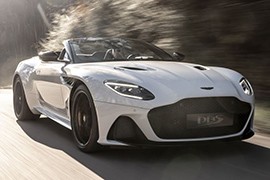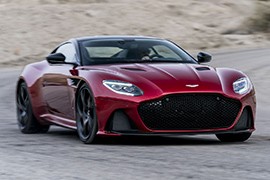ASTON MARTIN DBS Models/Series Timeline, Specifications & Photos
First production year: 1967
Engines: Gasoline
Body style: Coupé (two-door)
Aston Martin said farewell to its mighty flagship lineup DBS in 2023 after it introduced the final version, named DBS770 Ultimate, which was available in a coupe and a convertible shape.
The British automaker produced 300 units of this magnificent coupe, and the sales started long before the car was publicly announced. Compared to many other special editions, this DBS770 Ultimate didn't just provide a few new lines on the hood and new upholstery inside the cabin. Instead, it was a refreshed vehicle that included upgrades in all areas, including under the hood.
On the outside, the DBS770 featured a new front bumper fitted with a broad air intake in the middle and a pair of lower-mounted scoops to cool the brakes. In addition, the hood featured a more aggressive vent that helped cool the mighty twin-turbo V12 that powered the car. On the sides, the Ultimate received a set of 21" alloy wheels available in three finishes: Satin Silver, Sating Black, and Sating Black with Diamond Turned.
Aston Martin also worked its magic on the car's interior and installed standard Sports Plus Seats wrapped in semi-aniline leather and Alcantara. These were stitched in a quilted pattern. As an option, the automaker offered a set of performance seats that were more useful for those who wanted to take the car to the track and unleash its full potential. Another visual upgrade was offered on the gearshift paddles, which were made from carbon fiber. Last but not least, a laser-etched DBS770 Ultimate logo was imprinted on the center armrest.
Under the hood, the car was fitted with the same 5.2-liter V12 twin-turbocharged that was already known from its previous versions. Only this time, it developed 770 PS, 45 more than on the original 2018 model-year DBS.
In April 2019, Aston Martin showed the open-top version of its top-model, the DBS Superleggera. In the tradition of the British Company, the cabriolet was named Volante.
It is strange that Aston Martin struggled to make a super-light (Superleggera) coupe, and then it added 150 kg (330 lbs) by chopping off the roof. The good thing about the added weight to the rear part of the car is that it balanced the car to a 50/50 weight distribution. The DBS still kept the David Brown letters in its name, to honor the former owner of the Aston Martin company.
The design was the same as the DBS coupe up to the A-pillars. What happened after that, it happened that the B- and C-pillars were gone and a sexy sleek open-top bodywork was exposed. In the rear, on the trunk-lid, there was a small spoiler. The Aston Martin engineers succeeded to lose only 3 kg (6.6 lbs) of downforce when compared to the coupe version.
Inside, there was a GT design for the interior. Even if the car was fitted with a 2+2 seating, the rear ones were unusual especially if the wind-stopper was installed. But it did help with the taxes.
Under the hood, the DBS Superleggera Volante featured the same 5.2-liter twin-turbo V12 engine as the Superleggera coupe. It was mated to an 8-speed automatic transmission, mounted in the back of the car to help the balance.
The Superleggera nameplate first came to be in 1967. The British luxury car manufacturer marked the name's return on the grand tourer market with the DBS Superleggera in 2018. The new model represents a genteel, extremely stylish and sophisticated take on the fast-luxury coupe segment.
The DBS Superleggera is equipped with a 5.2-liter twin-turbocharged V12 engine paired with a new rear-mounted ZF 8-speed automatic transmission and develops 725 hp. The car can accelerate from 0 to 100 kph (0-62 mph) in 3.4 seconds and has a top speed of 340 kph. The driver can choose between three driving models: GT, Sport and Sport Plus.
Compared to the DB11, even though they share the same platform and basic engine, the DBS is a more muscular machine. It is 72 kg lighter than its predecessor, thanks to the carbon-fiber panels and driveshaft. The power is delivered to the wheels via a new high-torque version of ZF's 8-speed gearbox mounted in a transaxle fashion.
We've already settled that its exterior design is different and special, and the interior makes no exception, with premium quality materials and attention to details: a combination of Caithness leather and Alcantara leather with impeccable stitchings.
The car runs on 21-inch rims and Pirelli A7 P Zero tires that were specifically developed for this model. The Superleggera is equipped with keyless entry, tire pressure monitoring, a 360-degree camera, DAB radio an satellite navigation.
Aston Martin revived the DBS nameplate in 2007 at the Pebble Beach Concours D'Elegance after a 35-year hiatus for the British grand tourer.
Based on the same VH platform as the DBR9, the DBS appeared just before the 2007 world financial crisis began and bit the automotive industry. But that didn't stop the British car manufacturer from creating one of the last products developed and launched under Ford's ownership.
Everything on the DBS' look was about power and ambition to create a unique experience for its drivers. The shell-like grille was flattened and stretched on most of the front fascia, while a complementary air intake in the apron complemented the cooling area. Its swept-back headlights onto the front fenders were similar to those installed on the DB9. Yet, the flared wheel arches that allowed for wider tires and the vents on the hood warned the bystanders that it wasn't just a regular V8-powered Aston Martin. At the back, the carmaker didn't want to spoil the clean, fluid look of the car with a massive wing, but it installed a discrete small lip spoiler on the trunk. To complete the sporty image, the automaker placed a dual exhaust that peaked under the rear bumper flanking a black diffuser.
Inside, the DBS carried over several design elements from its siblings. While some of the switches and buttons were also received from Ford, other elements were unique such as the aluminum trims and the steering wheel. A set of aluminum pedals and the six-speed gear stick reminded the driver that it wasn't just an ordinary vehicle. Like any Aston Martin from that era, the DBS sported a leather-clad interior and sports seats with integrated headrests embroidered with the model's logo.
Under the hood, the automaker installed a 5.9-liter V8 that was derived from the racing unit installed in the DBR9 and DBRS9 race cars. Power went to the rear wheels via a transaxle, rear-mounted gearbox, and a limited-slip differential.
Designed as a four-seat grand tourer, the DBS was the rightful successor of the DB6. Still, the carmaker was somehow afraid to let it drive the brand alone on the market, and the two GT cars were offered side by side for three years.
By the mid-60s, Aston Martin's victory in Le Mans was not yet forgotten, and rich people still asked for a British grand tourer. Thus, the carmaker felt obliged to deliver something unique, with more appeal for those who asked for more comfort. The DB6 was good but not good enough for some people's tastes. And here came the DBS, a car that was more luxurious and more expensive than the nimble DB6.
With the DBS, the carmaker installed the four headlights design instead of its already traditional two-headlights layout. Moreover, the grille didn't sport that obvious shell shape as on its DB6 sibling. Also, unlike its brother, the DBS showed more clear lines and a squared front fascia. Yet, the extended wheelbase allowed for longer doors and wider side windows. The sloped rear end with a flat trunk lid created the image of the perfect GT of the late '60s.
Inside, the carmaker was able to fit four full-size seats. The front bucket ones featured headrests and mild side bolstering, while the rear ones were just good enough to travel shorter distances. Since it was a car designed for spirited drivers, the DBS sported a new dashboard design and a three-spoke steering wheel. The center stack hosted the sound system and the ventilation controls.
Under the hood, the DBS was gifted with a 4.0-liter inline-six powerplant that produced 280 hp (286 PS). In 1969, the carmaker added a 5.3-liter V8 that could pump up to 320 hp (324 PS).




